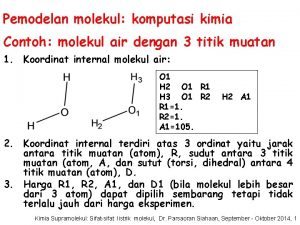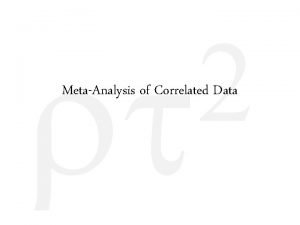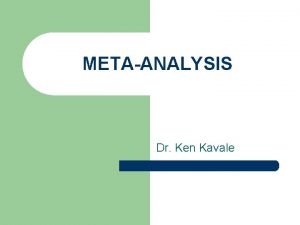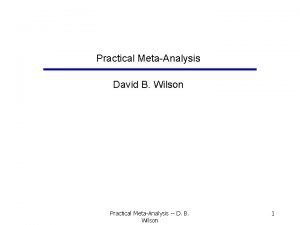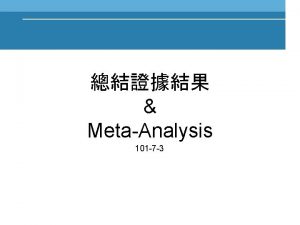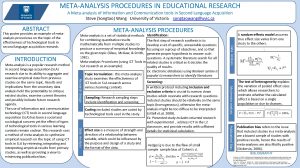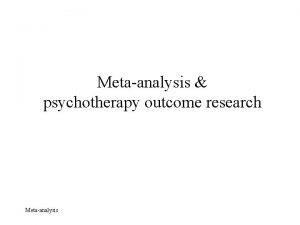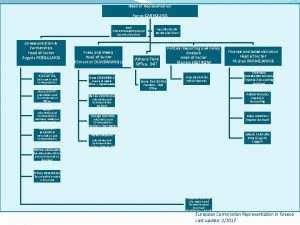Modelling individual patient data in network metaanalysis Areti


















- Slides: 18

Modelling individual patient data in network metaanalysis Areti Angeliki Veroniki, MSc, Ph. D Prepared for: 2016 CADTH Symposium April 11, 2016 E-mail: Veroniki. A@smh. ca Knowledge Translation Program, Li Ka Shing Knowledge Institute, St. Michael's Hospital, Toronto, Canada

Knowledge Translation, Li Ka Shing Knowledge Institute, St. Michael's Hospital, Toronto, Canada I have no actual or potential conflict of interest in relation to this presentation

Knowledge Translation, Li Ka Shing Knowledge Institute, St. Michael's Hospital, Toronto, Canada of the presentation • To increase knowledge about what an individual patient data (IPD) network meta-analysis (NMA) is • When an IPD-NMA may be preferred compared to an aggregated data (AD) NMA? • To increase knowledge of the methods for conducting an IPDNMA • Which methods are frequently performed for an IPD-NMA? • To discuss methods to obtain IPD • Which are the most efficient methods to get IPD? 3

Knowledge Translation, Li Ka Shing Knowledge Institute, St. Michael's Hospital, Toronto, Canada Aggregate data (AD) vs. Individual patient data (IPD) (network) meta-analysis AD meta-analyses: use summary point estimates from all patients enrolled in each included trial • Data are not available on individual patients IPD meta-analyses: use data from each individual patient enrolled in each included trial • Allows similar analysis across all trials • Allows investigation of patient-level moderators Aggregate data meta-analysis • May suffer from relatively low statistical power • It is challenging to: • • • Harmonize variable definitions Harmonize inclusion and exclusion criteria Combine studies with different follow-up times Adjust for study-specific biases (e. g. aggregation bias) Explore sources of between-study heterogeneity (e. g. due to treatment-covariate interactions) 4

Knowledge Translation, Li Ka Shing Knowledge Institute, St. Michael's Hospital, Toronto, Canada AD vs. IPD (network) meta-analysis • AD and IPD models can be equivalent if data & effect size are equivalent • Discrepancies arise because IPD data sets include different data than AD (e. g. may reinstate patients originally excluded, additional follow-up data) • IPD meta-analysis in soft tissue sarcoma: 24% of patients were excluded in the treatment arm compared with 20% in the control arm – 99% of excluded patients were recovered • • Meta-analysis with exclusions: HR=0. 85 (p=0. 06) Meta-analysis reinstating all exclusions: HR=0. 90 (p=0. 16) Tierney and Stewart Int J Epidemiol 2005 • Empirical evidence suggests AD models might be misleading for the evaluation of consistency assumption, and might suggest different ranking due to differences in a patient-level covariate distribution within and across studies. Donegan et al Stat Med 2012 • IPD meta-analysis is the gold standard for synthesising evidence across clinical trials, as it can: • Increase precision • Explore the patient-level treatment effects • Tailor results to the patient characteristics • Use consistent inclusion/exclusion criteria across studies Riley et al BMJ 2009

Knowledge Translation, Li Ka Shing Knowledge Institute, St. Michael's Hospital, Toronto, Canada AD vs. IPD (network) meta-analysis Individual patient data meta-analysis ü Includes checks to ensure homogeneity, quality of randomization, and follow-up analysis ü Overcomes outcome reporting bias ü Allows participant-level covariates to be directly modeled, increasing statistical power and detects participant-treatment relationships if they are present. • Answers what interventions are most effective in (for example): - men versus women - older people versus younger people ⊠ Is time-consuming and costly ⊠ May not be able to obtain all IPD = retrieval bias Simmonds et al Contemp Clin Trials 2015 ⊠ “…the balance of gains and losses of the approach will vary according to the disease, treatment, and therapeutic questions explored” Stewart and Tierney Eval Health Prof 2002 6

Knowledge Translation, Li Ka Shing Knowledge Institute, St. Michael's Hospital, Toronto, Canada A IPD in indirect comparisons C IPD indirect comparisons are published with increasing frequency in health care literature 2014* B The use of IPD in indirect comparisons and network meta-analysis (NMA) may: 2013 2012 2011 2010 2009 2008 2007 0. 0 2. 5 5. 0 7. 5 Number of publications 10. 0 • Increase confidence in the results • Identify interactions that are otherwise undetectable • Reduce both variation in treatment effects between studies within pairwise comparisons (heterogeneity) and variation in treatment effects between pairwise comparisons (inconsistency) • Allow estimation of subgroup effects, which in turn allows tailoring of results to patient characteristics * Up to October 2014 Veroniki et al BMC Med Res Methodol 2016

Knowledge Translation, Li Ka Shing Knowledge Institute, St. Michael's Hospital, Toronto, Canada Of the 33 empirical networks 1 1 1 2 3 1 1 2 Discipline spi Re ds Me tho Inf Dis ect eas Ga str o co nae Gy Ne uro 1 rat IPD-NMA MAIC or STC Both IPD-NMA and MAIC/STC Psy ch 2009 En do 1 2 1 dio 1 2 2010 2008 2007 1 iat psy ric ch 1 2 s 2012 2011 1 Ped 2013 5 1 tric 2 Ob ste 1 He ma t On ol co 2014* Car We identified 37 papers: o 23 (62%) application articles o 11 (30%) methodological articles o 2 (5%) reviews, and o 1 (3%) protocol. Year of publication Scoping review of indirect comparisons with IPD * Up to October 2014 (including examples identified in methodological and review articles): • 24 (73%) IPD-NMAs & 9 (27%) matching adjusted indirect comparison (MAIC) methods were performed • Included RCTs only: 21 (64%) IPD-NMAs and 9 (27%) MAICs • Only 9 (27%) IPD-NMAs reported the existence of a study protocol • 15 (45%) IPD-NMAs applied a random-effects model (this model is not applicable for MAIC) • 16 (52%) applied a Bayesian hierarchical model Veroniki et al BMC Med Res Meth 2016 • Only 3 (9%) IPD-NMAs provided their statistical code

Knowledge Translation, Li Ka Shing Knowledge Institute, St. Michael's Hospital, Toronto, Canada Scoping review of indirect comparisons with IPD • Of the 33 empirical networks o 21 (64%) networks with at least one closed loop: § 19 (90%) were IPD-NMAs, 13 (68%) of which evaluated the consistency assumption § Only 5 (38%) of the 13 IPD-NMAs used statistical approaches. o 10 (30%) were able to obtain IPD for all studies o 22 (67%) studies identified IPD from a collaborative group • 17 (46%) studies of the total 37 articles, were industry sponsored • For IPD alone or IPD+AD, models have been developed for dichotomous and continuous outcomes, whereas for IPD+AD, models also exist for time-to-event data. • Typical IPD network: dichotomous, objective primary outcome, compared pharmacological and placebo/control interventions, and involved 5 interventions and 10 trials. In summary… q One in three approaches used to model IPD adjusted results from different trials to estimate effects as if they had come from the same, randomized, population. q Key methodological and reporting elements were often missing, even for NMAs published in high impact journals. Veroniki et al BMC Med Res Methodol 2016

Knowledge Translation, Li Ka Shing Knowledge Institute, St. Michael's Hospital, Toronto, Canada Process for an IPD-NMA • Eligible trials identified by search as in an AD review • Identify contact information for authors published each eligible study • Response to request may vary (e. g. , no reply, no with reason provided, yes - will send the data, yes – here is the data) • Data format and supporting material may vary per IPD received

Knowledge Translation, Li Ka Shing Knowledge Institute, St. Michael's Hospital, Toronto, Canada How to obtain IPD Aim To examine the impact of providing incentives to the researchers responsible for the trials eligible for an NMA to submit their IPD. RCT Authors Intervention Group Control Group Studies Within a Trial (SWAT) and Studies Within a Review (SWAR) http: //go. qub. ac. uk/SWAT-SWAR

Knowledge Translation, Li Ka Shing Knowledge Institute, St. Michael's Hospital, Toronto, Canada How to obtain IPD Initiatives to encourage data sharing and clinical transparency • The Clinical Study Data Request System: https: //www. clinicalstudydatarequest. com/ • The Yale University Open Data Access Project: http: //yoda. yale. edu/ Important consideration: protect the privacy and confidentiality of research participants (anonymised data sharing)

Knowledge Translation, Li Ka Shing Knowledge Institute, St. Michael's Hospital, Toronto, Canada Process when IPD are obtained… • Understand the data (check the protocol and decipher the variable codes) • Reproduce published results • Check the data (e. g. , missing participants, chronological randomization sequence) • Raise queries and discuss them with original authors • Clean and prepare data in a common format across all studies • Recode data to a consistent format • Define outcomes of interest consistently across trials • Perform analysis of the data • Share results with data providers for discussion (if needed) • Report findings according to the Preferred Reporting Items for a Systematic Review and Meta-analysis of Individual Participant Data (PRISMA-IPD) guidelines Stewart et al JAMA 2015

Knowledge Translation, Li Ka Shing Knowledge Institute, St. Michael's Hospital, Toronto, Canada Network meta-analysis using IPD Safety and effectiveness of long-acting versus intermediate-acting insulin for patients with type 1 diabetes mellitus (T 1 DM) Tricco et al BMJ 2014; 349: g 5459 Severe Hypoglycemia Baseline glycosylated hemoglobin (A 1 C) NPH[od] Detemir[od/bid] Detemir[od /bid] NPH[qid] NPH[od/bid] 6 Detemir [qid] Detemir[qid] 2 1 1 Detemir [od] 1 4 1 1 1 8 2 1 NPH[od/bid] 4 7 1 Glargine [od] 1 Detemir[od] Glargine [bid] Glargine[bid] 1 1 Glargine[od] Veroniki et al BMJ Open 2015; 5: e 010160 Aim To update our previous systematic review and perform an IPD-NMA to evaluate the comparative safety and effectiveness of long- vs. intermediate-acting insulin in different subgroups of patients with T 1 DM.

Knowledge Translation, Li Ka Shing Knowledge Institute, St. Michael's Hospital, Toronto, Canada Network meta-analysis using IPD Comparative safety and effectiveness of cognitive enhancers for Alzheimer’s dementia Tricco et al ODPRN 2015 Veroniki et al BMJ Open 2016; 6: 1 e 010251 Aim To update our previous systematic review and perform an IPD-NMA to examine the comparative effectiveness and safety of cognitive enhancers for different patient characteristics.

Knowledge Translation, Li Ka Shing Knowledge Institute, St. Michael's Hospital, Toronto, Canada In summary…. Why applying an IPD-NMA? • Individual study results do not answer all potentially relevant clinical questions – Previous NMAs based on AD may have limitations • Enables further research to benefit medical research and patient care • Enables tailoring results to patient characteristics, and hence improving existing guideline recommendations • Enables the validation of individual study results • Helps in avoiding duplication of research, unnecessarily enrolling patients into clinical trials and exposing them to possible risks (e. g. , serious adverse events) • Increases transparency But… • Further studies are needed to evaluate the assumptions and the properties of an IPD-NMA in complex networks of interventions

Knowledge Translation, Li Ka Shing Knowledge Institute, St. Michael's Hospital, Toronto, Canada References… 1. Donegan S, Williamson P, D'Alessandro U, et al. Assessing the consistency assumption by exploring treatment by covariate interactions in mixed treatment comparison meta-analysis: individual patient-level covariates versus aggregate trial-level covariates. Statistics in medicine 2012; 31(29): 3840 -57. 2. Donegan S, Williamson P, D'Alessandro U, et al. Combining individual patient data and aggregate data in mixed treatment comparison meta-analysis: Individual patient data may be beneficial if only for a subset of trials. Statistics in medicine 2013; 32(6): 914 -30. 3. Kovalchik SA. Survey finds that most meta-analysts do not attempt to collect individual patient data. J Clin Epidemiol 2012; 65(12): 1296 -9. 4. Riley RD, Lambert PC, Abo-Zaid G. Meta-analysis of individual participant data: rationale, conduct, and reporting. BMJ. 2010; 340: c 221. 5. Simmonds M, Stewart G, Stewart L: A decade of individual participant data meta-analyses: A review of current practice. Contemporary clinical trials 2015, 45(Pt A): 76 -83. 6. Stewart LA, Clarke M, Rovers M, Riley RD, Simmonds M, et al. Preferred Reporting Items for Systematic Review and Meta-Analyses of individual participant data: the PRISMA-IPD Statement. JAMA. 2015; 313(16): 1657 -65. 7. Tricco AC, Ashoor HM, Antony J, Beyene J, Veroniki AA, Isaranuwatchai W. , et al. , Safety, effectiveness, and costeffectiveness of long-acting versus intermediateacting insulin for patients with type 1 diabetes: a systematic review and network meta-analysis. BMJ; 2014; 349: g 5459. 8. Tudur Smith C, Dwan K, Altman DG, Clarke M, Riley R, Williamson PR, Sharing Individual Participant Data from Clinical Trials: An Opinion Survey Regarding the Establishment of a Central Repository. Plo. S One. 2014; 9 (5): e 97886 9. Veroniki AA, Straus SE, Ashoor HM, Hamid JS, Yu C, Tricco AC. Safety and effectiveness of long-acting versus intermediate-acting insulin for patients with type 1 diabetes: protocol for a systematic review and individual patient data network meta-analysis. BMJ Open. 2015; 5(12): e 010160. 10. Veroniki AA, Straus S, Ashoor H, Hamid J, Hemmelgarn B, Holroyd-Leduc J et al. Comparative safety and effectiveness of cognitive enhancers for Alzheimer’s dementia: protocol for a systematic review and individual patient data network meta-analysis. BMJ Open. 2016; 6: 1 e 010251. 11. Veroniki AA, Straus S, Ashoor H, Stewart LA, Clarke M, Tricco AC. Contacting authors to retrieve individual patient data: study protocol for a randomized controlled trial. Trials. 2016; 17: 138 e 010251.

Knowledge Translation, Li Ka Shing Knowledge Institute, St. Michael's Hospital, Toronto, Canada Special thanks to: • My supervisor and mentors: Dr. Sharon E. Straus, Dr. Andrea C. Tricco • CIHR Banting Postdoctoral Fellowship Program E-mail: Veroniki. A@smh. ca
 Areti tsimounis
Areti tsimounis What is metaanalysis
What is metaanalysis Comprehensive metaanalysis
Comprehensive metaanalysis Patient 2 patient
Patient 2 patient Unit 5 data modelling assignment 2
Unit 5 data modelling assignment 2 Data modelling techniques in business intelligence
Data modelling techniques in business intelligence Trendlines and regression analysis
Trendlines and regression analysis Data modelling methodologies
Data modelling methodologies Power platform data modelling
Power platform data modelling Data modelling
Data modelling Envelope method of drug distribution
Envelope method of drug distribution Gesundheit central european lung cancer patient ne
Gesundheit central european lung cancer patient ne What is technological modelling
What is technological modelling Homology modelling steps
Homology modelling steps Giuliano casale
Giuliano casale Molecular modelling laboratory
Molecular modelling laboratory Modelling madness
Modelling madness Modelling rich interaction
Modelling rich interaction Lbo case study
Lbo case study















